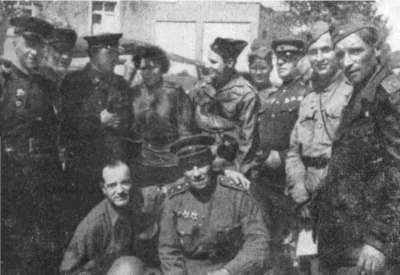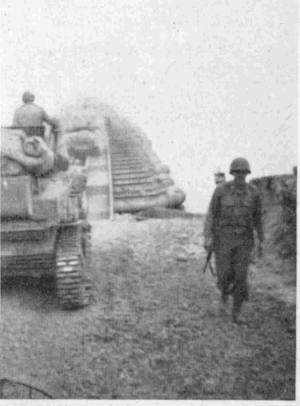| SIGNIFICANT AND INSIGNIFICANT DATES |
| 29 March 1944 | Headquarters and Headquarters Battery, Division Artillery, 6th Armored Division formed on Division Order. |
| 19 July 1944 | Headquarters Battery, Division Artillery, aboard the Liberty ship, John J. Whittier, lay off the Utah beachhead awaiting debarkation. |
| 23 July 1944 | First vehicles of Division Artillery rolled on French soil and spent the night near the town of St. Germanin. |
| 29 July 1944 | Division Artillery with the Division commited into combat. Division Artillery RO party captured two Germans hiding in a house, our first two prisoners. On this day the cognac run through France and Germany was officially begun. |
| 31 July 1944 | Three miles northwest of Avranches we had our first encounter with the famed Luftwaffe. |
| 1 August 1944 | Bivouac area of Division Artillery outside Avranches, strafed amidst considerable excitement, amusing incidents, but no casualties. |
| 2 August 1944 | Just outside of Dinan, Division Artillery was moved ahead of the combat column to mass artillery fire on Dinan. We pulled hastily into position in an area filled with enemy infantry. We were without infantry support. The battery captured four prisoners and a Volkswagen. |
| 3 August 1944 | Chaplain Schwer and Tec. 5 Forrest R. Nelson disappeared. Their fate was learned only after our arrival at Lorient. They had been ambushed; Chaplain Schwer was killed and Tec. 5 Nelson taken prisoner. |
| 6 August 1944 | S-2, S-3, Message Center vehicles of Division Artillery column were pinned down by sniper fire as they moved through Lesneven. |
| 8 August 1944 | Division reorganized and regrouped for attack on Brest. A division staff officer went into Brest with a surrender ultimatum. This was rejected by the German general. |
| 9 August 1944 | The attack of Brest was postponed due to severe enemy artillery fire and a threat to our rear by the 266th German Infantry Division. The division compeltely reserved its direction of movement and moved to the north in three columns to meet the threat. While its advance guard, now the rear guard, fought a holding action, the other elements attacked the advancing German column. During these engagements, General Spang, Commanding General of the 266th Infantry Division, along with his staff was captured. The German division was completely disorganized and its effective combat strenght destroyed. |
| 10 August 1944 | Attack on the outposts of Brest begun. |
| 15 August 1944 | After beseiging Brest for several days, the Division moved on to a new mission, to contain Lorient. |
| 25 August 1944 | The Division held a memorial service for those who gave their lives in the drive to Brest. Chaplain John M. Schwer was the only member of Headquarters Battery to so give his life. |
| 7 September 1944 | Colonel Lowell M. Riley came from England to resume command of the Division Artillery. |
| 13 September 1944 | Relieved from mission of containing Lorient by the 94th Infantry Division. |
| 15-18 September 1944 | Bivouaced in the Foret de Orleans for a period of refitting and retooling which turned out to be a period of feasting on captured German delicacies. |
| 22 September 1944 | Unit committed into action in vicinity of Jallacourt. And the rains came. |
| 26 September 1944 | Moved into St. Max, just outside of Nancy, France. |
| 29 October 1944 | Unit moved into the Foret de Faco for more fighting and more rain. |
| 1-9 November 1944 | The dark days of Foret de Faco ... rain, mud. mire, and no mail. |
| 10 November 1944 | Division Artillery crossed the Seille River under cover of darkness and bivouaced at Vigny. |
| 11 November 1944 | Battery area was shelled by the guns of.Fort Orny. |
| 15 November 1944 | The battery's constant companions, new sleeping bags, were issued at Vatimont. |
| 22 November 1944 | Lt. Bryant and Cpl. Sewell received shell fragments in their. "Peep." Lt. Bryant was wounded. |
| 24 November 1944 | The "Battle Wagon" officially became a member of the Battle family. |
| 4 December 1944 | This was beginning of a long, pleasant stay at Farschviller. |
| 25 December 1944 | A hurried dash for a hurried meal and a short stay in Metz. |
| 30 December 1944 | Fire Direction Center established at Clochimont, the beginning of our part to break the hold on the Bastogne Bulge. |
| 1 Januaray 1945 | Artillery fire directed by Divion Artillery repulsed an enemy counterattack in the vicinity of Wardin. The first of many counter attacks in the area. |
| 3-4 January 1945 | Heavy artillery fire on Command Post in Bastogne. S-2 vehicle damaged by shell fragments. |
| 5 January 1945 | Col. Riley interviewed by war correspondents from Time magazine. |
| 15 January 1945 | Command Post in Bastogne received heavy fire from 170mm guns. The liaison officer from one of our attached battalions was injured by shell fragments. M/Sgt. Chisholm went out into the open during the fire to obtain medical and for the officer. He was later awarded the Silver Star for his act of gallantry. |
| 20 January 1945 | Two officers and one enlisted man from the 450th Bomber Squadron, 322nd Bomber Group visited the unit. |
| 25 January 1945 | Division Artillery moved to Trois Vierges, bringing to an end the greatest pressure that had been brought to bear on the Bastogne Bulge. |
| 27 January 1945 | Division Artillery Moved to Eselborn where the Division held control of the famed sky line drive frfom which our elements could look down into Germany and observe the Siegfried defenses. |
| 8 February 1945 | Division breaks throught Siegfried defenses. |
| 5 March 1945 | Back into fraternizing territory in Vianden, Luxembourg. Here Division Artillery went into reserve for the first time in 221 days of consecutive combat. |
| 25 March 1945 | At 1645 throught a blinding smoke screen, Division Artillery crfossed the Rhine River on a pontoon bridge; in the vicinity of Oppenheim. |
| 29 March 1945 | An all day drive up the Reichsautobahn, the German super highway . . . the first of many long and fast drives. |
| 7 April 1945 | Struth, Germany, a town in which we were billeted, three days previously, was reduced by our artillery fire when the Germans quickly reentered it as we advanced. |
| 14 April 1945 | At Frankenau, the eastward sweep of the 6th Armored Divsion halted pending arrangements with the Russians. |
| 8 May 1945 | VE Day . . . Ossa, Thüringen, Germany. |

